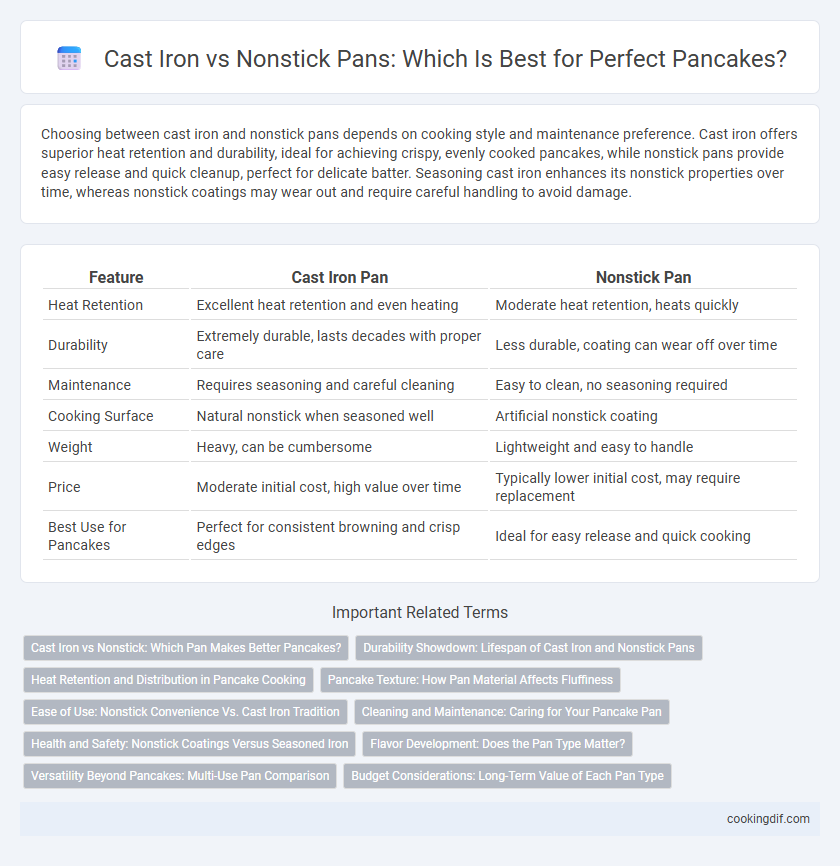Choosing between cast iron and nonstick pans depends on cooking style and maintenance preference. Cast iron offers superior heat retention and durability, ideal for achieving crispy, evenly cooked pancakes, while nonstick pans provide easy release and quick cleanup, perfect for delicate batter. Seasoning cast iron enhances its nonstick properties over time, whereas nonstick coatings may wear out and require careful handling to avoid damage.
Table of Comparison
| Feature | Cast Iron Pan | Nonstick Pan |
|---|---|---|
| Heat Retention | Excellent heat retention and even heating | Moderate heat retention, heats quickly |
| Durability | Extremely durable, lasts decades with proper care | Less durable, coating can wear off over time |
| Maintenance | Requires seasoning and careful cleaning | Easy to clean, no seasoning required |
| Cooking Surface | Natural nonstick when seasoned well | Artificial nonstick coating |
| Weight | Heavy, can be cumbersome | Lightweight and easy to handle |
| Price | Moderate initial cost, high value over time | Typically lower initial cost, may require replacement |
| Best Use for Pancakes | Perfect for consistent browning and crisp edges | Ideal for easy release and quick cooking |
Cast Iron vs Nonstick: Which Pan Makes Better Pancakes?
Cast iron pans provide even heat distribution and excellent heat retention, resulting in pancakes with a crispy exterior and fluffy interior. Nonstick pans offer easy release and quick cleanup, making them ideal for beginners or those seeking convenience. For artisanal pancakes with superior texture, cast iron is often preferred, while nonstick pans suit fast, fuss-free cooking.
Durability Showdown: Lifespan of Cast Iron and Nonstick Pans
Cast iron pans boast exceptional durability, often lasting several decades when properly maintained, due to their robust material and ability to withstand high heat without damage. Nonstick pans, while convenient for easy release and cleaning, typically have a shorter lifespan of 3 to 5 years as the coating degrades with frequent use and exposure to metal utensils or high temperatures. Choosing cast iron ensures long-term investment and resilience, whereas nonstick pans require more frequent replacement to maintain performance.
Heat Retention and Distribution in Pancake Cooking
Cast iron pans excel in heat retention, maintaining consistent high temperatures crucial for even pancake cooking and browning. Nonstick pans offer quicker heat distribution but may have less thermal mass, leading to temperature fluctuations that can affect pancake texture. Choosing cast iron ensures superior heat stability, resulting in uniformly cooked pancakes with a perfect golden crust.
Pancake Texture: How Pan Material Affects Fluffiness
Cast iron pans retain and distribute heat evenly, resulting in pancakes with a crispy exterior and a tender, fluffy interior. Nonstick pans heat faster but can create pancakes with a softer texture due to less consistent heat distribution. Choosing cast iron ensures optimal heat retention for thick, airy pancakes, while nonstick pans offer convenience and ease of flipping but may yield slightly less fluffy results.
Ease of Use: Nonstick Convenience Vs. Cast Iron Tradition
Nonstick pans offer superior ease of use for pancakes, requiring less oil and providing effortless flipping with minimal sticking, ideal for quick and convenient cooking. Cast iron pans deliver even heat distribution and durability, creating a crispy, golden crust but demand seasoning and careful maintenance to prevent food from adhering. Choosing between nonstick convenience and cast iron tradition depends on balancing straightforward cleaning and consistent nonstick performance with the rich flavor and classic texture achieved by cast iron cookware.
Cleaning and Maintenance: Caring for Your Pancake Pan
Cast iron pancake pans require seasoning and hand-washing with minimal soap to maintain their nonstick surface and prevent rust. Nonstick pans offer easier cleaning with gentle scrubbing and dishwasher-safe options, but their coating can degrade over time if exposed to harsh utensils or high heat. Proper maintenance of cast iron extends its lifespan, while careful use preserves the nonstick performance and safety of coated pans.
Health and Safety: Nonstick Coatings Versus Seasoned Iron
Cast iron pans, when properly seasoned, offer a natural nonstick surface free from synthetic chemicals, reducing exposure to potentially harmful compounds found in some nonstick coatings. Nonstick pans often contain PTFE or PFOA, which can release toxic fumes if overheated, posing health risks. Choosing cast iron enhances safety by avoiding chemical coatings while also offering durability and even heat distribution for optimal pancake cooking.
Flavor Development: Does the Pan Type Matter?
Cast iron pans enhance flavor development in pancakes by providing superior heat retention and even cooking, creating a caramelized, crispy crust that intensifies the taste. Nonstick pans offer convenience and easy release but often lack the ability to achieve the Maillard reaction as effectively, resulting in less complex flavor profiles. Selecting cast iron optimizes flavor depth due to its seasoning properties and consistent high heat.
Versatility Beyond Pancakes: Multi-Use Pan Comparison
Cast iron pans offer superior heat retention and durability, making them ideal for searing, baking, and frying beyond pancakes. Nonstick pans provide ease of use and quick cleanup, excelling in delicate foods like eggs and crepes, but may lack the versatility and high-heat performance of cast iron. Choosing between cast iron and nonstick depends on your cooking style and the range of dishes you plan to prepare.
Budget Considerations: Long-Term Value of Each Pan Type
Cast iron pans offer superior long-term value by withstanding high heat and developing a natural nonstick surface through seasoning, often lasting decades with proper care. Nonstick pans typically require replacement every 2-5 years due to coating degradation, impacting overall cost-effectiveness despite lower initial prices. Investing in cast iron can be more budget-friendly over time, especially for frequent pancake cooking and versatile kitchen use.
Cast iron vs nonstick for pan choice Infographic

 cookingdif.com
cookingdif.com